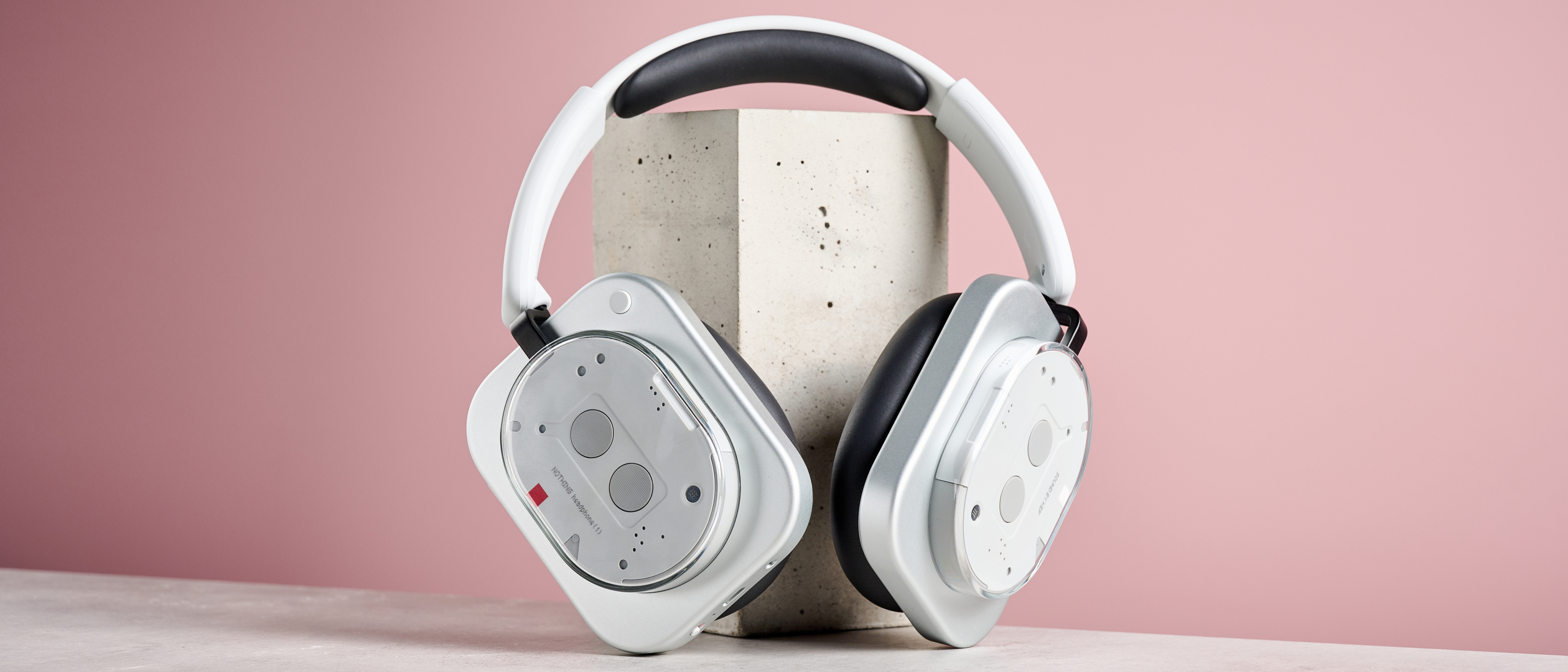TechRadar Verdict
The Nothing Headphone (1) are technically incredibly impressive, delivering tons of useful features, a great app that enables you customize in smart ways, and strong active noise cancellation. But the sound is lacking considering their premium price, without the openness and dynamic punch I'd expect at this level. The design divides people, but I find it charming, and the build quality is exquisite, and the on-ear controls are superb. If it weren't for the sound, I'd love them. As it is, I like them – but I think most people should stick with Sony.
Pros
- +
Comfortable and great build quality
- +
Tons of smart features that work well
- +
Strong noise-cancellation modes
Cons
- -
Sound feels compressed
- -
Fairly heavy
- -
The looks are divisive
Why you can trust TechRadar
Nothing Headphone (1): Two-minute review
The Nothing Headphone (1) are the first-ever over-ear headphones from the still-fairly-new tech company, joining its smartphones and a range of earbuds – including one model we rated as a five-star smash hit: the Nothing Ear (a).
While Nothing's earbuds are all mid-range or cheaper, however, the Nothing Headphone (1) are in competition with the best noise-cancelling headphones at a premium level, due to their $299 / £299 / AU$549 price. That's what you pay for a pair of Sony WH-1000XM5 today – so do they stand up to one of the biggest names in wireless headphones?
Well, the Nothing Headphone (1) are a product of two halves. When it comes to the technical side of things, they absolutely won me over. They're crammed with features, ranging from tweakable active noise cancellation, to useful audio customization, to USB-C lossless sound support, to spatial audio.
With the exception of the limp spatial audio, these all work excellently, and when you pair them with fantastic on-ear controls – including a 'Roller' button that changes the volume (plus other functions) and is maybe my favorite button on a pair of headphones ever – and superb build quality, they feel well worth their price.
Sadly, the sound quality isn't at the same level. The audio is tuned by the great hi-fi brand KEF, and is reasonably refined, well-balanced, and broadly enjoyable. But it also feels compressed, and lacks the openness and expansive sound I'm used to from testing the competition at this price.

I tested them directly against the Sony WH-1000XM5, and far preferred the extra breadth and detail the Sony cans offer. I also compared them to the Sennheiser Accentum Plus headphones, which can be bought for about half the price, and preferred the sound of those too.
That's the key divide in the Nothing Headphone (1): premium price, premium features, but mid-range sound. But it's why you buy headphones, and it needs to match the rest.
Sign up for breaking news, reviews, opinion, top tech deals, and more.
There is another divide of sorts: the aesthetics, which some people like a lot, and some people detest. You'll have to make your own mind up. The headphones are comfortable and extremely well-made, though, there's no question about that.
If (well, when) they get a price drop, these could be great headphones. As it stands, I'd suggest you go for the Sony WH-1000XM5 at this price, or another option among our round-up of the best headphones.
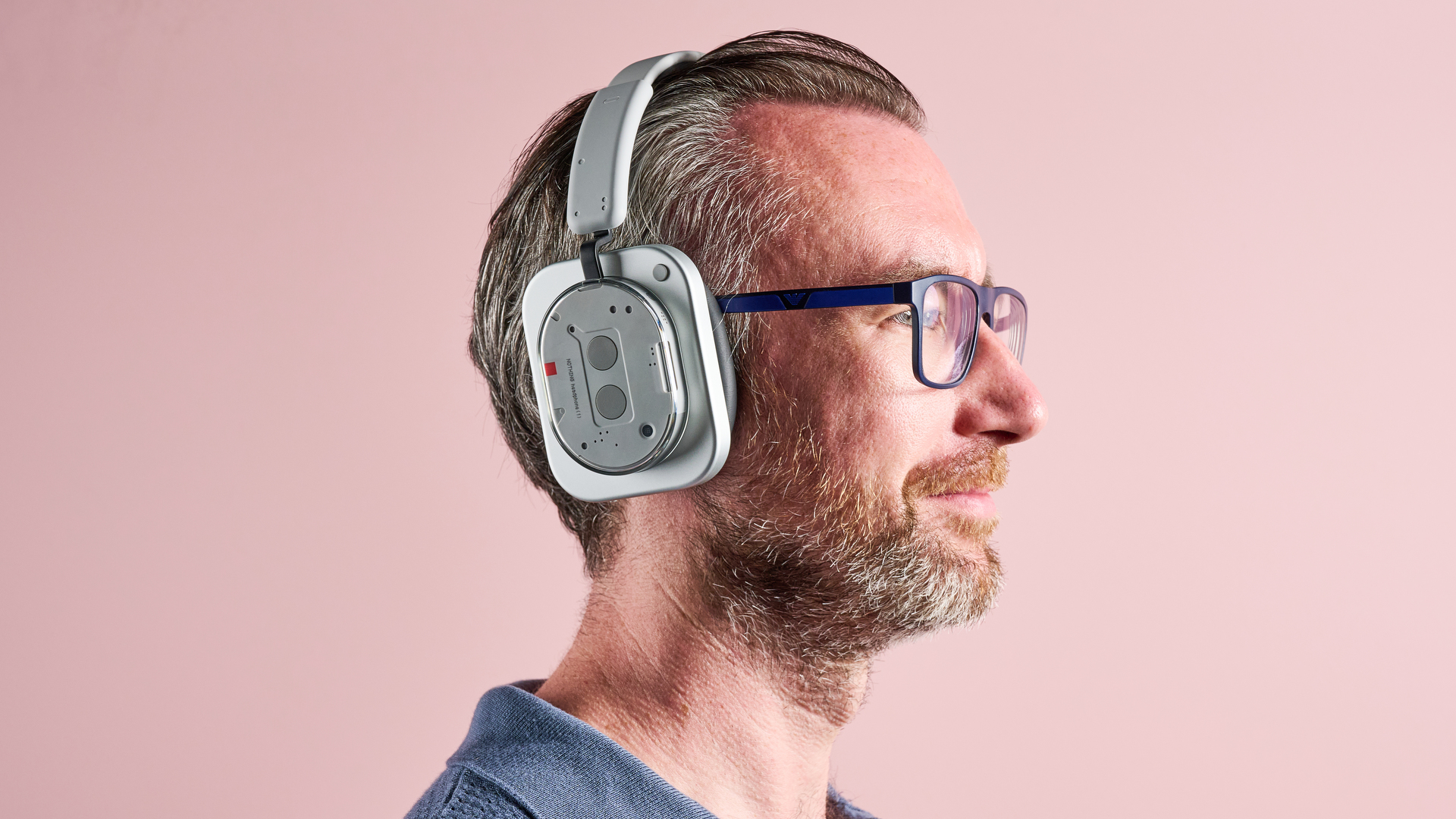
Nothing Headphone (1) review: Price and release date
- $299 / £299 / AU$549
- Released on July 15, 2025
Nothing's previous earbuds releases have all played in the budget-to-mid-range pool, but the Nothing Headphone (1) are going in at the premium deep end.
Their price of $299 / £299 / AU$549 matches the current street price of the Sony WH-1000MX5, and in the US is about the same price as the Bose QuietComfort Headphones. In the UK, you can get the Bose QuietComfort Ultra Headphones for only a little more at the time of writing, and they often drop to a similarly competitive price in the US too.
That's pretty hardcore company, but the Nothing Headphone (1) are still significantly less expensive than the newest Sony WH-1000XM6, which come in at $449 / £399 / AU$699; and when it comes to features, the Nothing are closest to the XM6 and the Bose Ultra.
I'd also expect them to be available for less than their full price before too long. This is fairly standard with Nothing's earbuds, and the Nothing Ear (a) are now available at an effectively standard price that's far less than their launch price, which puts them top of our list of the best budget earbuds. Perhaps the Headphone (1) will drop before long; for now, though, I'm reviewing them based on their full price.
Nothing Headphone (1) review: Specs
Drivers | 40mm dynamic |
Active noise cancellation | Yes |
Quoted battery life | ANC on: up to 35 hours. ANC off: up to 80 hours |
Weight | 329g |
Connectivity | Bluetooth 5.3 |
Frequency range | 20Hz-40kHz |
Waterproofing | IP52 |
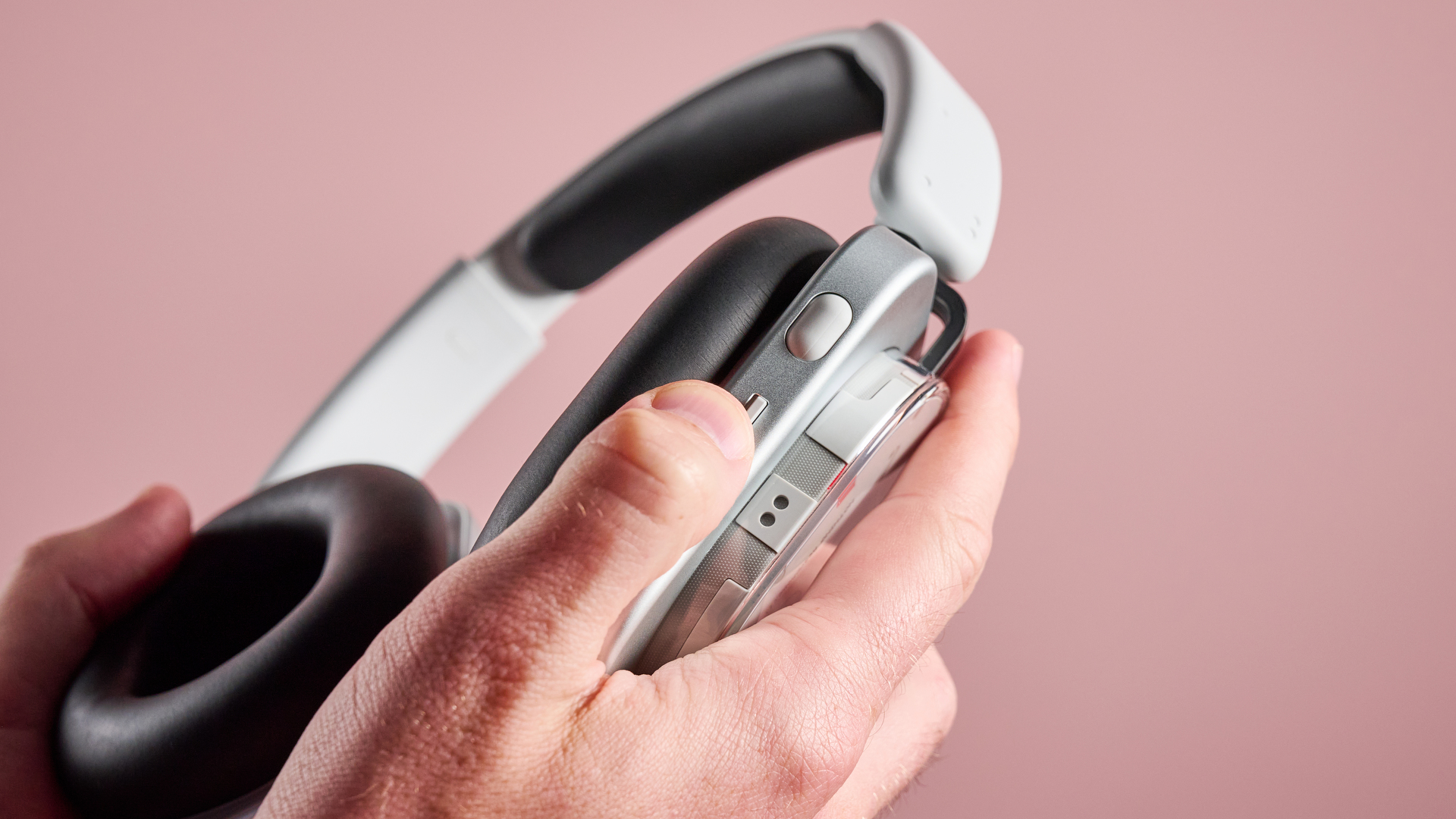
Nothing Headphone (1) review: Features
- Multiple noise-cancellation modes and spatial audio options
- Lots of other customization options in the excellent app
- You might need to turn on some basic-seeming features
The Nothing Headphone (1) certainly justify their price when it comes to the list of features. You've got adaptive active noise cancellation with Transparency mode, head-tracked spatial audio, equalizer customization options, LDAC higher-res wireless audio, USB-C lossless Hi-Res Audio connectivity, a 3.5mm jack, multi-point Bluetooth to two devices, wear detection, Google Fast Pair, a customizable control button, and up to 35 hours of battery life with active noise cancellation turned on.
If you use them with the new Nothing Phone (3) you also get extra options, such as the option to use the customizable button to switch between your favorite audio apps, or active AI-based voice-note taking, in which your notes are automatically sorted into a relevant collection of notes on your phone.
Let's start with the noise cancellation, since it's the feature most people will use pretty much every time they turn on the headphones. You have three strength settings, plus 'Adaptive' – I was happiest sticking with 'High', but you might choose 'Low' for an office setting, say.
On High, the Nothing Headphone (1)'s noise-blocking power was essentially on a par with Sony WH-1000XM5 in my direct comparison. The noise cancellation does a great job of reducing sounds across the whole frequency range, and does it without interfering with the audio quality. I'd maybe give the Sony cans a 10% higher rating on higher-frequency noise reduction when listening to a podcast, but when listening to music, any difference between these two headphones was academic.
The noise cancellation isn't quite as good as you'll get on the Bose QuietComfort Ultra Headphones or Sony WH-1000XM6, but those cost more, so that's fair enough.
The Transparency mode works perfectly well, though it really emphasizes higher-frequency noises, such as crinkling a wrapper. This isn't uncommon, but the Sony XM5 cans maintained a more natural transparency sound when I compared them.
I also noted that when using Transparency mode and talking to someone, my own voice felt really boomy in my ears, far more so than with most of the premium headphones I've used for a while now, which is a bit distracting.
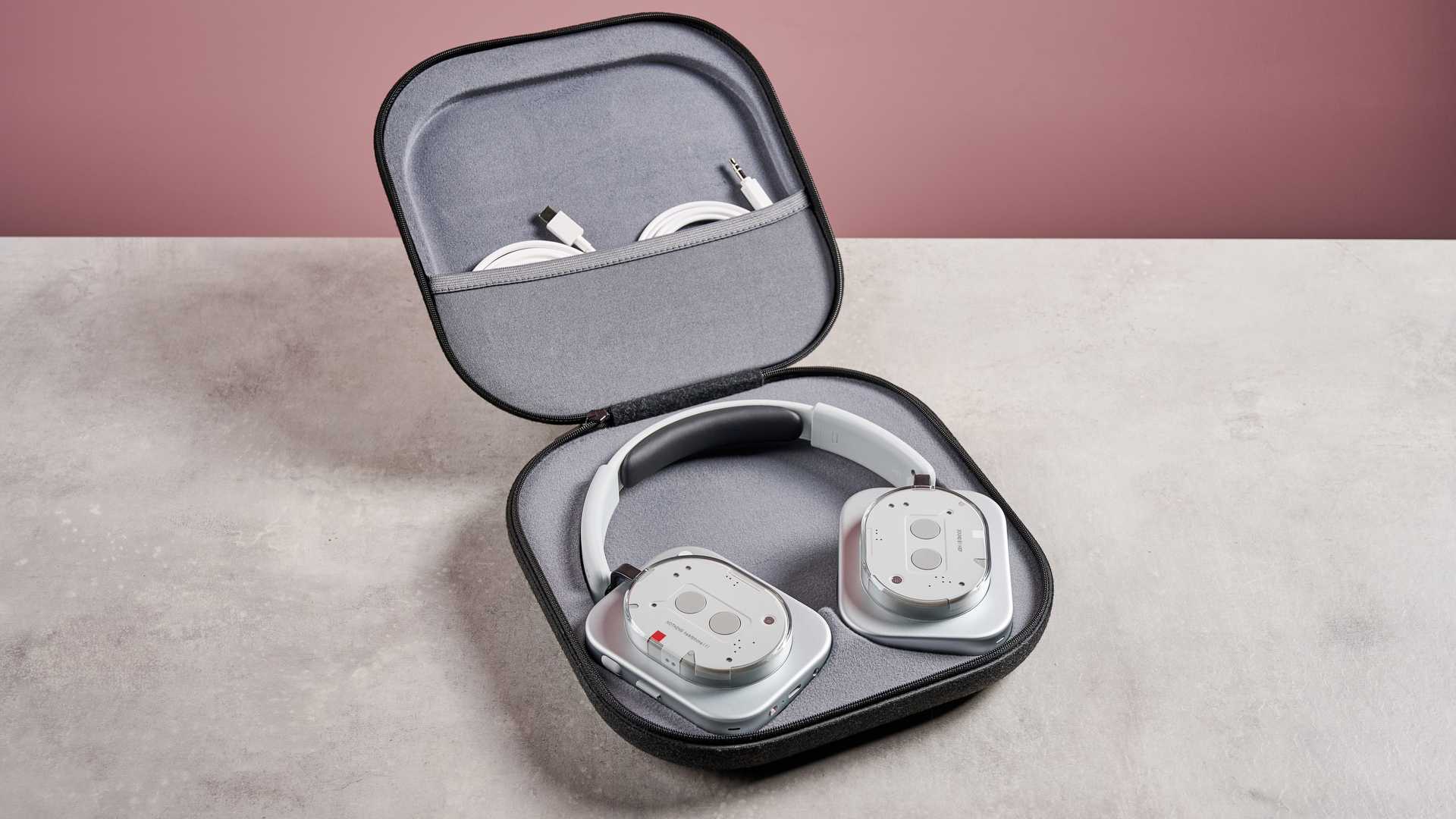
You can switch noise cancellation levels in the app, and you can switch between ANC or Transparency mode using the Roller button on the headphones. The sound that the headphones make to indicate when you've switched modes are my favorite I've ever heard on a pair of headphones – a small thing, but I genuinely loved it.
You hear the sound of a big intake of breath when you switch to Transparency mode, like a sound spirit has been freed from the captivity of ANC. Then, when you turn ANC back on, there's a sucking and shutting sound, denoting the noise being trapped – like the lid slamming back down on the Ark of the Covenant. There's zero confusion as to which mode you've switched to, unlike with some headphones.
When you've finished choosing your noise cancellation mode in the app you can also customize the sound, using two different EQ options and a separate Bass Enhancer tool. I'll get into the latter in the Sound Quality section next, but the EQ options initially give you the option of some named presets (such as 'Vocal'), or you can go into a truly custom mode with an eight-band EQ.
By default, the only way to activate the spatial audio mode, or the separate head-tracked spatial audio mode, is from the app. However, one of the other options you can customize in the app is a physical button near the top of the headphones, which you can use to trigger basically anything from within the app (plus the Nothing Phone (3)-specific options, such as the AI Assistant or switching audio apps). I decided to set this to switch spatial audio modes for my review period, which worked nicely.
I'll talk about the quality of spatial audio in the next section, but the short version is that I don't think it adds anything here, and actively harms the quality of watching videos or movies, sadly.
One slightly odd thing about these headphones is that the wear-detection (to auto-pause what's playing when you take them off) and multi-point Bluetooth (to connect to two devices at once) are both turned off by default, and these settings are hidden in the Device Settings screen rather than being somewhere obvious.
I kind of get it with multi-point Bluetooth – it's not uncommon for this to be turned off by default, and it could be confusing for people not used to the idea. But auto-pause should definitely be turned on by default! The good news is that both work perfectly.
When it comes to battery life we're promised 35 hours with active noise cancellation turned on, and 80 hours with it turned off. I didn't have time to test the latter claim during my review period, but I got just over 38 hours of real-world use from the cans with ANC on, and that was with spatial audio turned on at times as well, which uses even more power.
That puts the Nothing Headphone (1) comfortably above the 30-hour Sony WH-1000XM5 for battery life, but they can't compete with the mighty 60-hour stamina of the Cambridge Audio Melomania P100, or the Sennheiser Momentum 4 Wireless.
When it comes to microphone quality, these headphones are a little tinny and robotic, as many over-ear headphones are, but largely clear. Not bad, not impressive. I again broke out the Sony XM5 for comparison, and the two performed incredibly similarly – however, once again I heard my own voice booming far more in the Nothing in the Sony, which is a little unpleasant.
Features score: 4.5 / 5
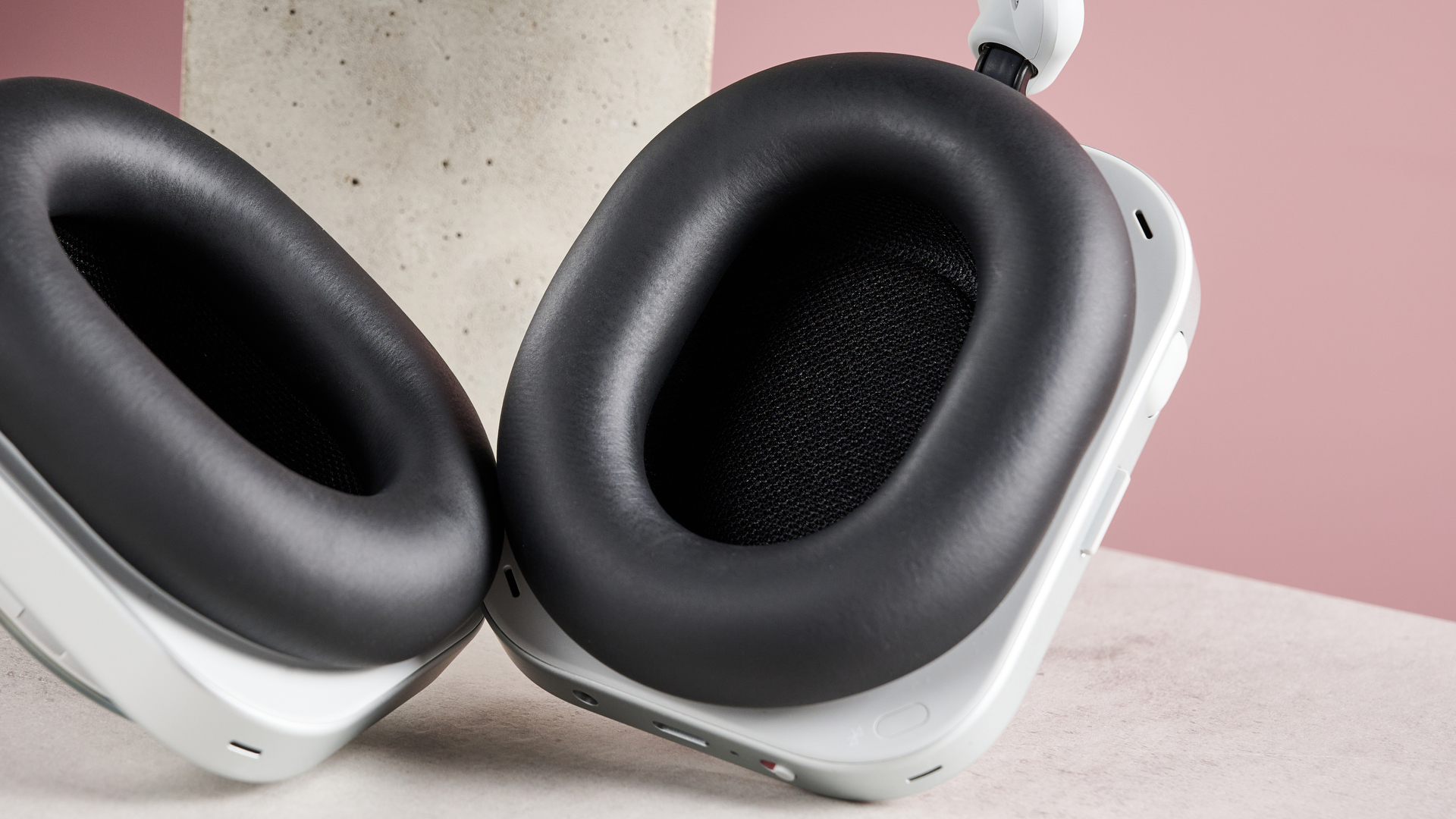
Nothing Headphone (1) review: Sound quality
- Well balanced with energetic low-end, especially with Bass Enhancer
- Limited dynamism and expansiveness
- Movie audio quality is weak, and spatial audio doesn't add anything
A quirk of timing meant that I received my Nothing Headphone (1) and starting testing them out before I knew their price. This meant that during my initial testing I had no preconceptions of how they should sound relative to their price; I just listened in isolation.
My instant reaction was "Oh, these must be much more mid-range than I expected from the design." I grabbed the Sennheiser Accentum Plus to do some comparison testing, since those are a top mid-range pick for us. And then I received the pricing information, and realized that these are not mid-range at all – but disappointingly the sound is.
The audio quality of the Nothing Headphone (1) is good, to be clear. But for their price, 'good' isn't good enough.
They're well-balanced across the frequencies, so the different elements of songs feel well represented, and no part seems to particularly overwhelm the others – as you'd hope, given the promise that the sound has been tuned by KEF.
The bass is muscular and impactful, but it still leaves space for the mid-range to feel solid. The treble is prominent without sticking out awkwardly, and delivers a reasonable amount of detail.
The problem is that it all feels bizarrely small and compressed. There's a surprising lack of expansiveness, and while the treble, mid and bass are all very well balanced they also feel shackled to each other, stuck dancing in a small group when then should be moving and spreading around the dance floor.
The sound never feels bigger than the earcups, and for this price, it should. I did direct listening comparisons, using the same music source, with the Sony WH-1000XM5, and you can feel that the music has more room to breathe in the latter.
Instruments separate better, voices sound more natural, the bass is more nimble and nuanced, the transient details are more defined in a way that gives the sound more solidity and realism, and there's a more expansive feeling to the mix.
The Nothing cans feel like they're lacking the fifth gear that other premium headphones have – when a song is supposed to open up into a climax of energy, the Nothing don't have any more headroom to offer.
If the Sony XM5's sound feels like it's coming from a pair of bookshelf speakers, the Nothing Headphone (1)'s sound feels like it's coming from a really good Bluetooth speaker; enjoyable enough given the limitations of the source, but simply lacking the scale and clarity you'd want.
I said that I was initially inclined to compare them to the Sennheiser Accentum Plus, and I'd put these two headphones roughly on a par. I prefer the Sennheiser's more open sound and extra touch of dynamism with small details, but the Nothing's energy and full bass will have their fans.
That's especially true if you activate the Bass Enhancer feature. I really like this! It adds more resonance and viciousness to low frequencies, in a good way. It won't be everyone's cup of tea, but it reaches deeper while maintaining total control over the sound. I would use this day-to-day with the headphones personally, for sure.
Bass Enhancer also gives you some fun extra flexibility choices when using the equalizer – for example, the Vocal preset on its own wasn't to my taste, but the Vocal preset with Bass Enhancer on was actually a tempting new option to listen with for a while.
The Sony XM5 are boomier in the bass than the Nothing, and with Bass Enhancer on I would say Nothing have the edge for low-end control and thrill, but it doesn't change the fact that I prefer the overall audio advantages of the Sony.
The spatial audio options ranged from middling to disappointing, in my opinion. They don't make music sound worse, but they don't really add to it. I felt no sense of anything new in the tracks with the basic non-head-tracking spatial mode enabled, I think mainly because it can't overcome the headphones' aforementioned overall problem of feeling like the sound is stuck right in the drivers next to your ears.
Switching to head tracking threw up an odd wrinkle, in that it always started with the 'centering' of the track being directly to my right, for whatever reason. If I kept my head looking forward it corrected itself after a few seconds.
The head tracking is good, but the lack of meaningful spatial upscaling means you don’t feel like you’re immersed in a performance in the way you can with Dolby Atmos head-tracking on the AirPods Max. It feels like sitting in front of a set of speakers; but, you know, not a very expansive set of speakers, because the headphones can't do that.
I'll also note here that spatial audio is no good with podcasts, since it throws a load of reverb into the mix, which just muddies things.
I tried movies as well as music, and the headphones' dynamic limitations really show themselves here. Epic movies feel smaller than they should, with dialogue trapped within the overall crush of the mix.
And spatial audio is even weaker here than it is with music – there was actually less directionality from the source soundtrack than when just listening in normal mode, I found. To go back to the Sony XM5, they delivered way more exciting movie audio, at a bigger scale, with harder impacts, and offering far clearer speech at the same time.
This has been quite a negative sound quality write-up, but I want to emphasize what I said at the top – they sound good. There's detail and good balance across the range, but you can get arguably better sound for half the price from Sennheiser, and definitely, in my opinion, better sound for the same price from Sony.
Sound quality score: 3.5 / 5
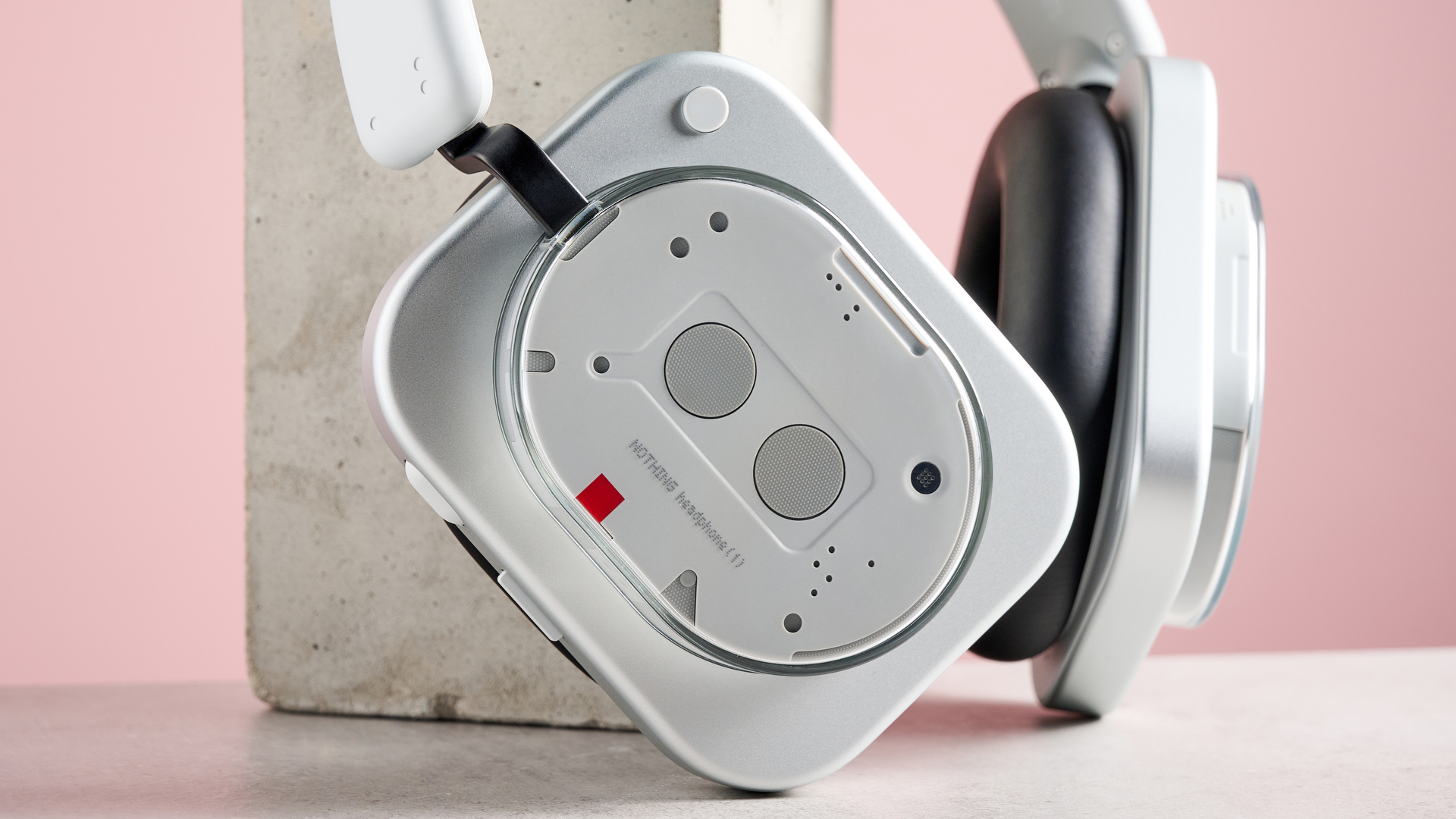
Nothing Headphone (1) review: Design
- Weighty, but comfortable to wear
- Headband adjusts further up than most headphones
- On-ear controls are excellent
Before we get into the practical side of the Nothing Headphone (1)'s design, we need to talk about the aesthetic side.
This is one of the most divisive pairs of headphones we've had in TR Towers for a while, and conform strongly to Nothing's penchant for clear cases and the feeling that the tech inside is showing – but mixed with Apple-esque clean, milled aluminum.
The gamut of responses in the office has run from "I love the look of them" to "I really like what they're doing, but I don't think I'd wear them" to "I think they're straight retro cool" to "If they were round I think I'd like them more" to "These are the ugliest headphones I've ever seen".
I'm not going to dwell on the aesthetics here because it's so personal – I think they're charming, but they're not really my style.
They feel high-quality, though – there's basically no give in the construction where there shouldn't be, and the finish on the aluminum and plastic elements is really premium.
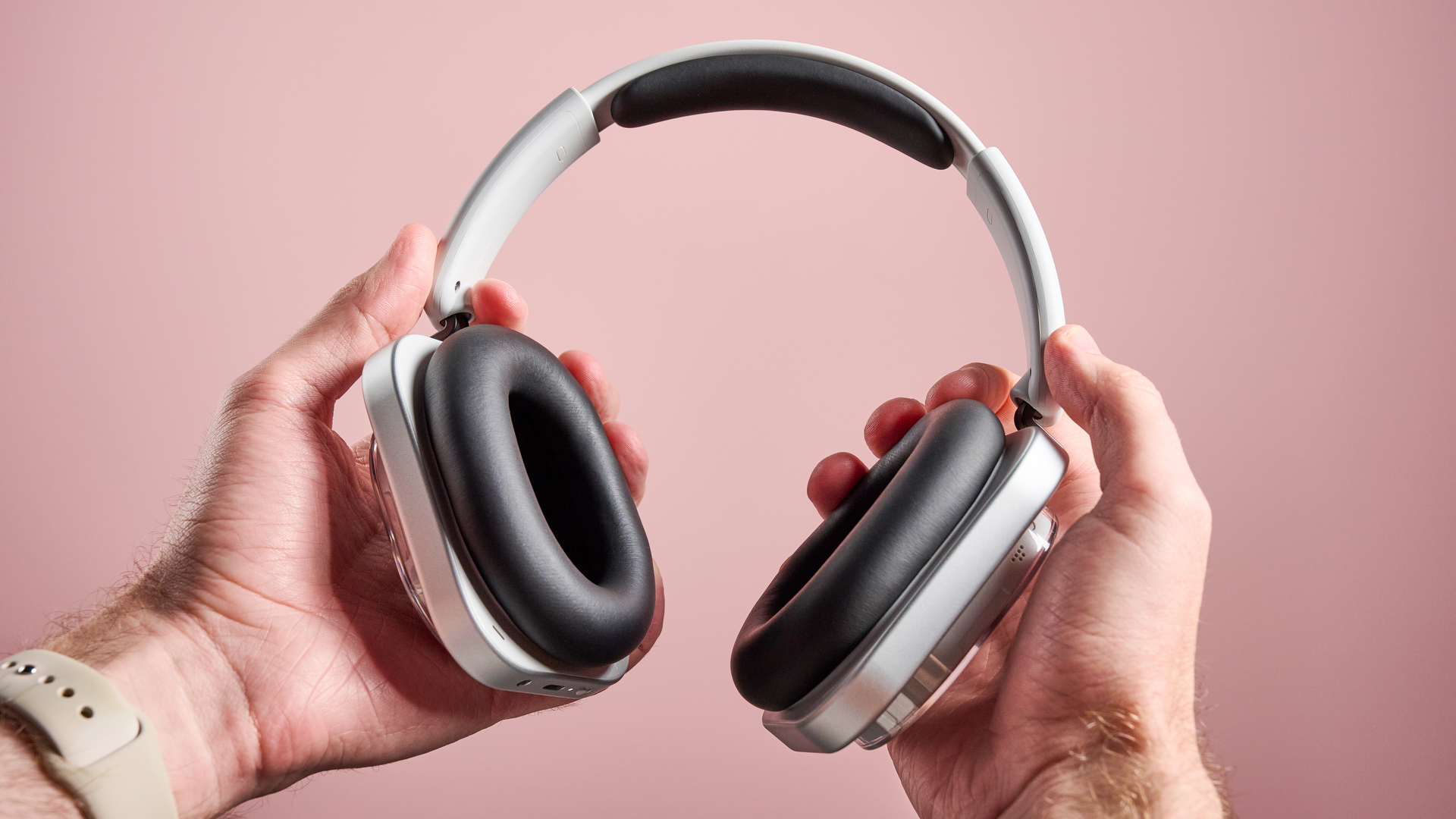
The earpads and headband cushion are PU leather, so they're vegan-friendly (an earlier version of this article said they were not – apologies for the error). Nothing says they're designed to resist skin oils, but in practice, this means they really pick oil up visibily, whether that's from your fingers while holding them or your head while wearing them. It wipes off instantly, which I guess is what Nothing is getting at, but just know that it'll really show.
In terms of fit and comfort, the wireless headphones they most remind me of are AirPods Max. At 329g, they weigh a little less than 384g AirPods Max – but notably more than the 250g of the Sony WH-1000XM6 – and like the Max they use a fairly strong clamping force to stay on.
This fit will also be a little divisive – some people really prefer just a lighter-weight headphone that doesn't need to grip so much – but I found them more comfortable than the AirPods Max, and fine to wear for a good stretch of time. The well-padded earcups help with this, holding firmly but softly, and they didn't struggle to fit around my glasses. Still, I was certainly aware of the weight more than when wearing my trusty Bose QuietComfort Ultra Headphones.
I could see this kind of firm, clamping fit being popular with gym-goers, as is the case with the AirPods Max – and also just as with the AirPods Max I'm not sure it's a great idea, for sweat-related reasons.

Having an IP52 rating for dust and water is better than having no rating at all, but it means they're rated only for very limited water ingress protection; I'd suggest that IPX4 is what you want to protect against sweat properly. But it's better than nothing, which is what most rivals offer.
There is one physical design I element I really dislike here, though, and it's the positioning of the adjustable portion of the headband near the top of the head, rather than down by the earcups. My usual method of adjusting headphones for a tighter fit is to to grip the earcups with my palm, hold the armband with my fingers and pull them a little higher when needed.
Here, you have to reach for the top of the headband, which feels much less precise, and my brain had a lot of trouble adjusting. I'm counting this as an "If it wasn't broken, why fix it?" design change.
On the other hand, I absolutely love the physical controls on the Headphone (1). On the back of the right-hand earcup is a 'Roller' control, which you can rotate to change volume, press once to play/pause, and press and hold to change between noise cancellation and Transparency mode.
It moves really smoothly, the finger grips it just the right amount, and I never accidentally rolled it when I meant to press it, or vice versa. It's a wonderful bit of design, and might be my favorite piece of physical control design on any headphones ever. I should note that my colleague Becky Scarrot found that the Roller made a noise that irritated her when she used it – I didn't have any issue, though.
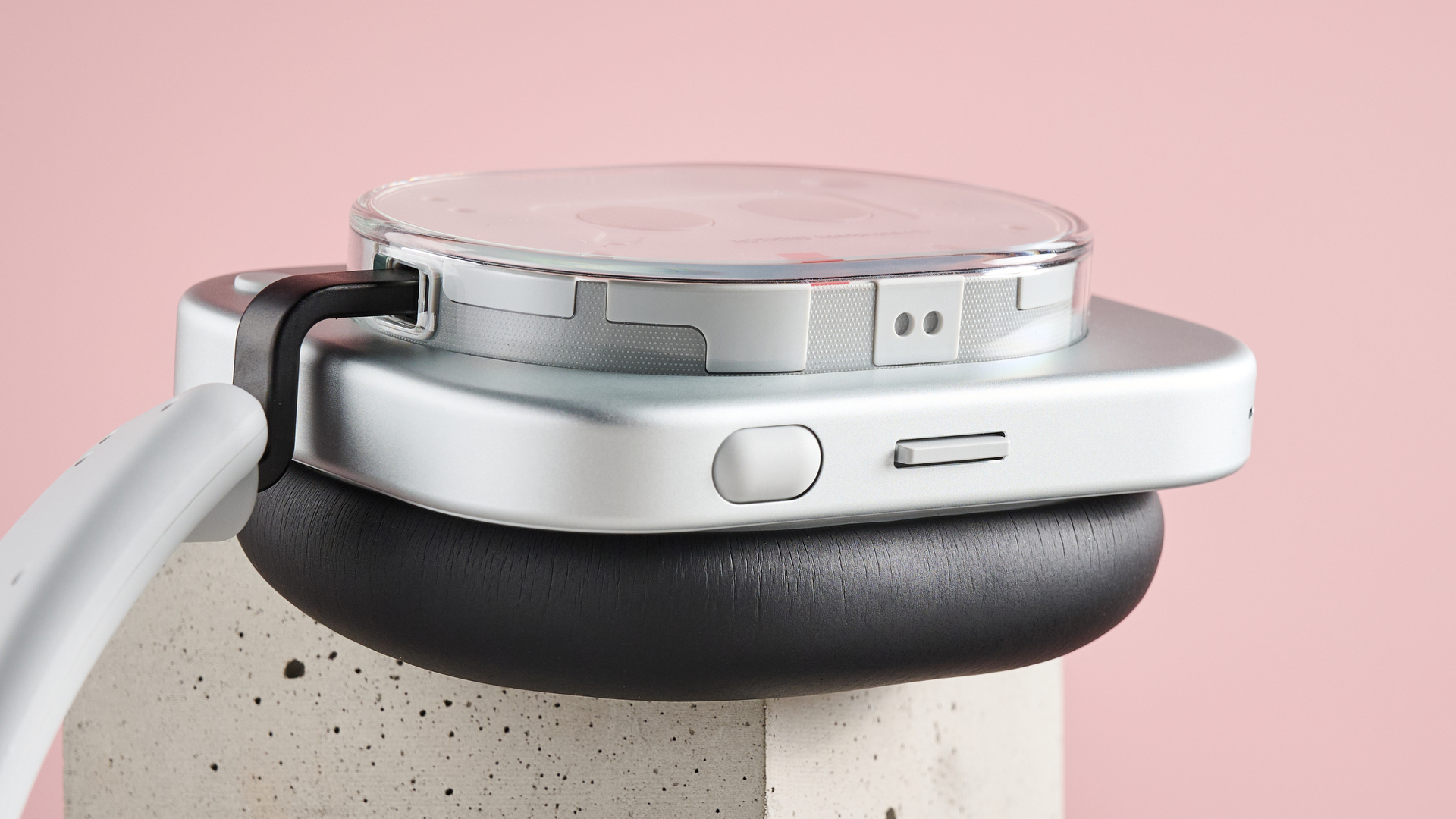
Below this is a rocker control, which you can push forward or back quickly to skip tracks, or hold in either direction to fast-forward and rewind – perhaps not a necessary control for many people, but as a podcast fan who's used to skipping through ads or being able to go back if I became distracted, I liked having the option.
Another button near the top on the outside of the rear earcup is totally customizable – used with a Nothing Phone handset, it can be used to change which music service you're listening to; on other phones it'll activate a voice assistant as one option. I ended up setting it to change spatial audio modes.
On the bottom of the right earcup are a physical on/off switch, the USB-C port, and the 3.5mm jack.
Design-wise, then, the Nothing Headphone (1) are an odd mix of things I love, things I dislike, and things that really got the TR office talking. The controls and build quality lead me to conclude that they're well-designed on balance, but how you feel about the look will probably be the deciding factor, and I can't make that call for you.
Design score: 4 / 5

Nothing Headphone (1) review: Value
- Excellent, well-implemented set of features
- High price sits well with feature list and build quality
- The sound drags the value way down, though
As I've said elsewhere in this review, the Nothing Headphone (1) not only justify their premium price when it comes to their features, they actually manage to feel like something of a bargain. Only the lack of Bluetooth LE Audio and Auracast prevents them from feeling truly future-proof, and those aren't widely used yet, so I can't really knock the value score on account of their absence.
They feel expensive too – whatever you think of the look, the quality under your fingers (and on your head) is clear, and elements as simple as the excellent roller control give you a little shot of satisfaction every time you use it, and reassure you that these are a well-made piece of tech, and that your money was well spent.
Alas, the sound is an anchor dragging all of that down. I think they sound arguably on par with, or perhaps slightly weaker than, the Sennheiser Accentum Plus headphones, which can be regularly found for a street price that's less than half of what Nothing is asking for the Nothing Headphone (1).
Balance it all out and they just about convince me that they're not actively bad value, but they're not good value either.
Value score: 3 / 5
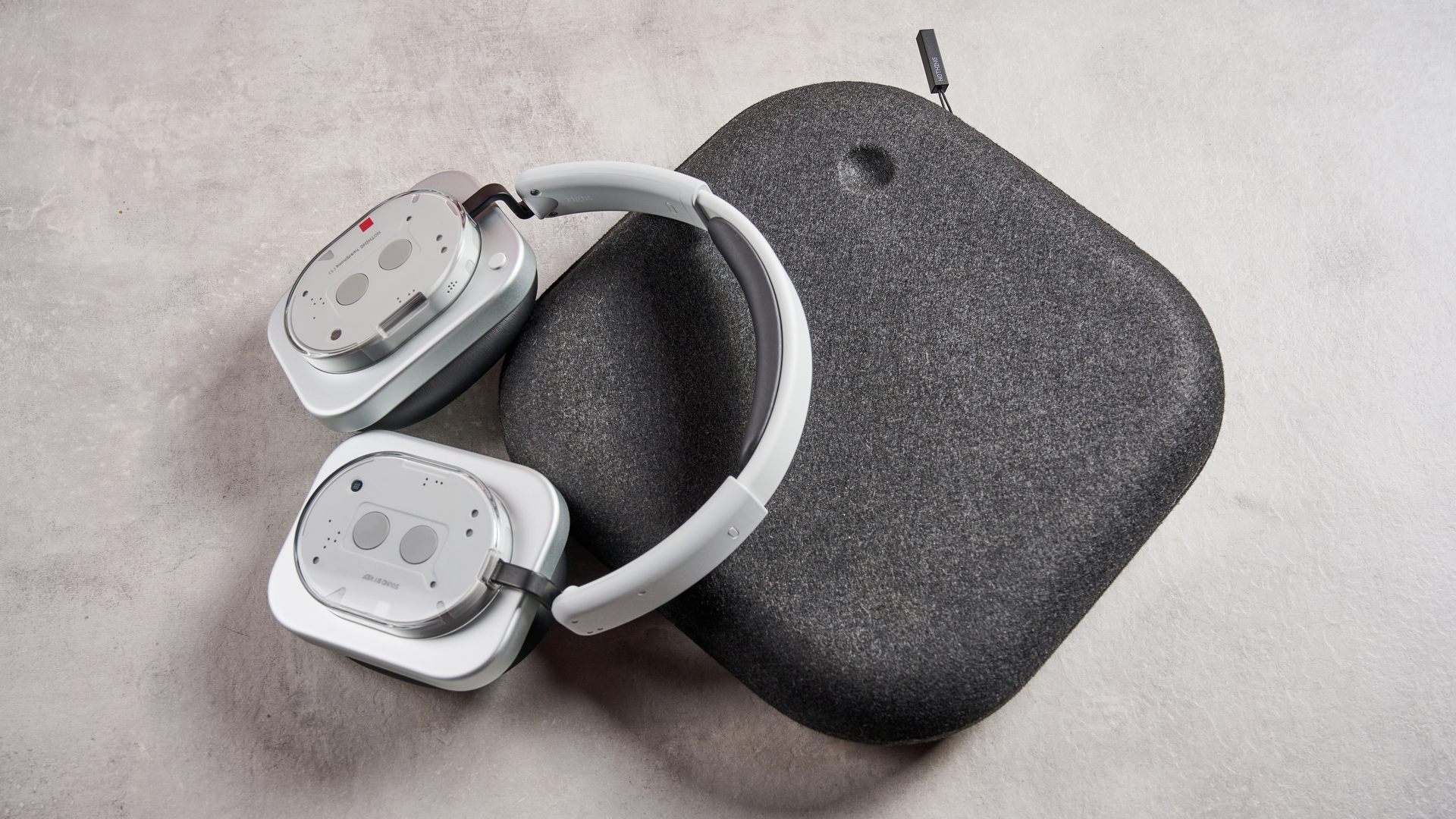
Should I buy the Nothing Headphone (1)?
Buy them if...
You want a unique look
They're the most striking pair of mainstream headphones in years, and are extremely well-built.
You want tons of control and customizability
Useful sound options, and the fully customizable button to add unique functionality are all really nice to have, and they have lots of connection options.
You'll use a Nothing Phone
They offer even more interesting options for Nothing Phone owners, including AI skills and instant switching between audio apps.
Don't buy them if...
Audio quality is your top priority
While they don't sound bad, they also don't sound good enough for the price – a lack of openness will frustrate both music and movie lovers.
You make a lot of calls
The call quality is average, but hearing your own boomy voice is frustrating, and other premium headphones generally avoid this.
You don't like heavy headphones
The Nothing headphones are comfortable, but you can feel their weight compared to far lighter options from Sony and Bose. That's the trade-off for the high-quality metal build.
Nothing Headphone (1) review: Also consider
| Header Cell - Column 0 | Nothing Headphone (1) | Sony WH-1000XM5 | Bose QuietComfort Ultra Headphones |
|---|---|---|---|
Price | $299 / £299 | About $299 / £279 | About $349 / £349 |
Drivers | 40mm dynamic | 30mm dynamic | 35mm dynamic |
Connectivity (wireless) | Bluetooth 5.3, LDAC | Bluetooth 5.3, LDAC | Bluetooth 5.3, Snapdragon Sound |
Weight | 329g | Row 3 - Cell 2 | 250g |
Connectivity (wired) | USB-C lossless audio, 3.5mm jack | USB-C (power only), 3.5mm jack | USB-C (power only), 3.5mm jack |
Sony WH-1000XM5
The newer Sony WH-1000XM6 are out, but they cost way more than the Nothing Headphone (1). The older Sony XM5, however, can now be found for the same price, if not cheaper, than the Nothing – and they sound better, and feel far lighter, if that's your preference. Read our full Sony WH-1000XM5 review for more on the intricacies of these headphones.
Bose QuietComfort Ultra Headphones
Another pair of headphones that are much lighter than the Nothing, and these also have a folding design, so are great for travel. They have better noise cancellation than the Nothing or Sony, and better sound too. Like the Nothing cans, they have a spatial audio mode that works by upscaling sound. They have around half the battery life of the Nothing headphones, though – although that was my only real complaint in my Bose QuietComfort Ultra Headphones review.

How I tested the Nothing Headphone (1)
- Tested for two weeks using pre-release Nothing app
- Tested at home, in the office, and while travelling
- I've been reviewing audio tech for 14 years
I had two weeks to test the Nothing Headphone (1) before their official launch as part of my regular routine, using a pre-release version of the official Nothing app to control their features.
I primarily used them with my iPhone 16 Pro over Bluetooth, and also connected them to my iPad Pro to test the multi-point Bluetooth. I also listening to USB-C lossless audio from these devices, and from my MacBook Air. I used a Fiio M23 music player for LDAC playback.
I tested the active noise cancellation on public transport, walking around city streets, in the TechRadar office, and at home. I listened to the TechRadar audio testing playlist, as well as many hours of whatever music I was in the mood for.
I compared them directly to the Sony WH-1000XM5 and Sennheiser Accentum Wireless headphones in listening tests.
To test the actual battery life I charged the headphones up to maximum, and then left them playing at 50% volume, with active noise cancellation turned on, for long periods, until I ran them down.
I've been testing audio products, including headphones, for around 14 years, ranging from early consumer Bluetooth options through to today's best wireless headphones of all kinds.
- First reviewed: July 2025
- Read TechRadar's Reviews Guarantee

Matt is TechRadar's Managing Editor for Entertainment, meaning he's in charge of persuading our team of writers and reviewers to watch the latest TV shows and movies on gorgeous TVs and listen to fantastic speakers and headphones. It's a tough task, as you can imagine. Matt has over a decade of experience in tech publishing, and previously ran the TV & audio coverage for our colleagues at T3.com, and before that he edited T3 magazine. During his career, he's also contributed to places as varied as Creative Bloq, PC Gamer, PetsRadar, MacLife, and Edge. TV and movie nerdism is his speciality, and he goes to the cinema three times a week. He's always happy to explain the virtues of Dolby Vision over a drink, but he might need to use props, like he's explaining the offside rule.
You must confirm your public display name before commenting
Please logout and then login again, you will then be prompted to enter your display name.
